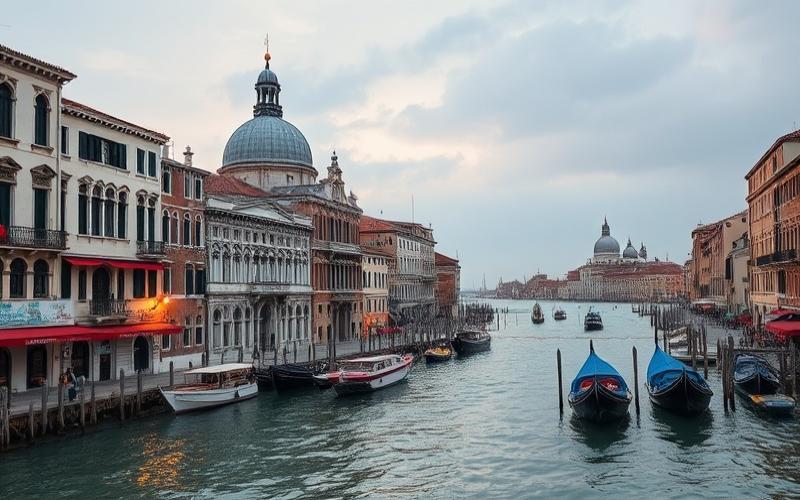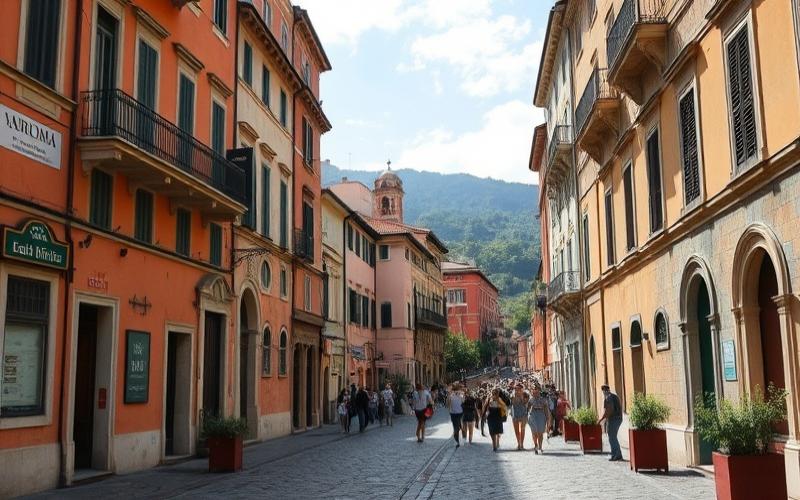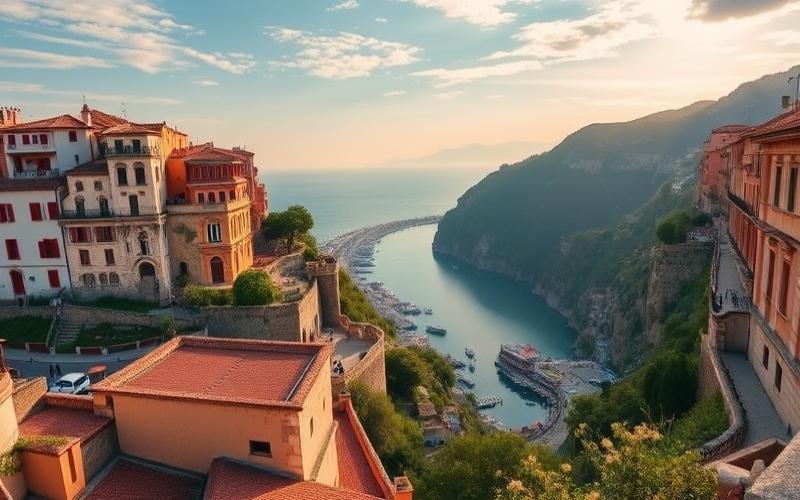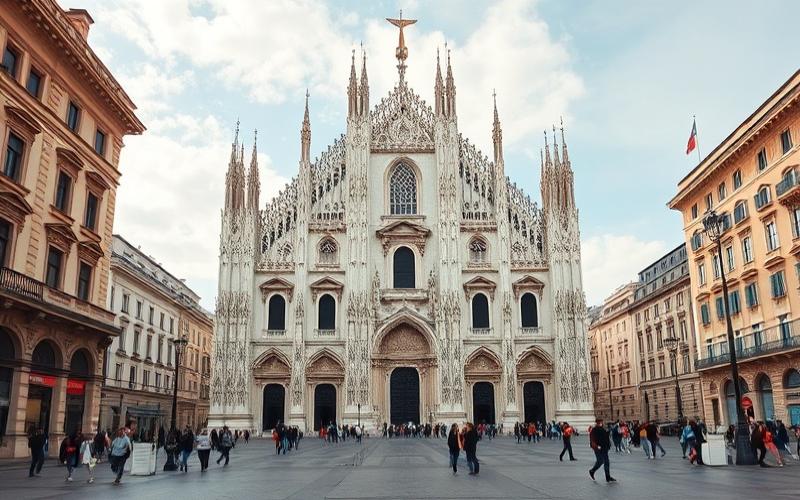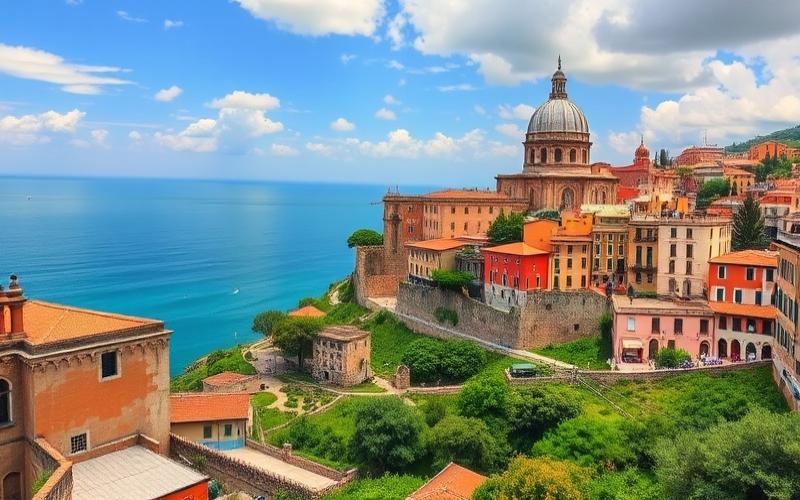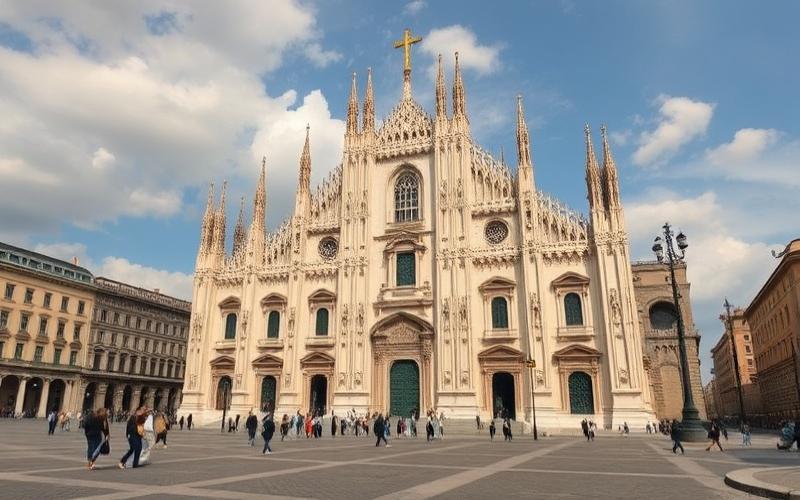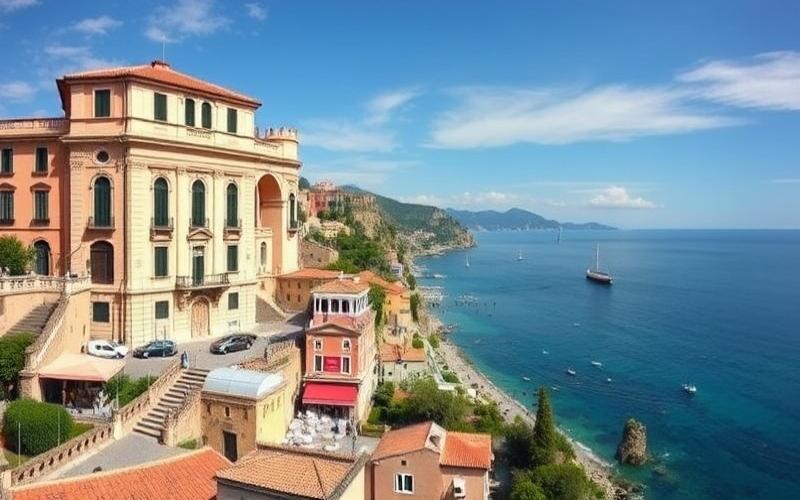
 Published on and written by Cyril Jarnias
Published on and written by Cyril Jarnias
Airbnb Rentals vs Long-Term Rentals in Italy: Which is the Most Profitable Solution?
In a real estate context where investment profitability is often scrutinized meticulously, Italy stands out as a mosaic of potential and challenges for property owners seeking to maximize their profits.
This article explores the thorny question of whether renting through Airbnb or long-term rentals prove more profitable in this country rich in culture and regional diversity.
Analysis of Key Figures in Major Italian Cities
Through an in-depth study, we examine how key factors influence these two investment approaches:
- The impact of the tourist season
- Local demand
- Current regulations
Comparison Between Major Destinations
From Rome to Milan, including the lesser-known gems of Tuscany, we scrutinize the economic and tourism dynamics:
| City | Airbnb Profitability | Long-Term Rental Profitability |
| Rome | High (seasonal) | Stable |
| Milan | Moderate | High |
| Tuscany | Very High (summer) | Low |
Good to Know:
Regulations on tourist rentals vary significantly from one Italian city to another, with particular restrictions in Venice and Florence.
Conclusion: Which Strategic Choice to Prioritize?
Our analysis provides an overview of the best strategies to adopt for real estate investors in Italy, depending on location and yield objectives.
Understanding Seasonal Rental Yields in Italy
The yield of seasonal rentals in Italy depends mainly on tourist location, property type, seasonality, and regulatory and tax framework, with demand peaks in major art cities like Rome, Florence, and Venice during spring and summer, and net profitability modulated by taxation (IRPEF or cedolare secca) and management and cleaning costs. Recent obligations (CIN registration number, platform withholding taxes) and local taxes (tourist tax) influence margins and require rigorous management compared to long-term rentals.
Main Characteristics of Short-Term Profitability
- Demand driven by international tourist flows, concentrated in art cities and coastal areas; high season generally extends from April to October, with peaks at Easter, May-June, August, and during major local events; in winter, demand remains sustained in Rome and Venice (festivals, holidays), more cyclical in Florence.
- Tax framework: choice between taxation under the IRPEF scale on net income (deductibility of certain expenses) or opting for the flat-rate cedolare secca at 21% on gross rents for non-professional rentals; some municipalities/regions apply local variants or reductions; declaration is mandatory including for non-residents.
- Regulatory framework: obligation to register and display the CIN (National Identification Code) on all listings; significant penalties for non-compliance; platforms/agencies handling collection must withhold 21% on collected rents under the flat-rate regime.
- Recurring costs: cleaning fees, laundry, supplies, platform or agency commission, tourist tax collected and remitted, routine maintenance; deductibility varies depending on the chosen tax regime (deductible under IRPEF, non-deductible under cedolare secca).
Comparison by Property Type
- Central Studios/1-Bedrooms: high occupancy rates due to city-break demand and pricing flexibility, higher turnover and more frequent cleaning costs per rented night.
- 2-3 Room Apartments: better average basket per family stay; balance between occupancy and ADR, sensitive to school holidays and cultural events.
- High-End Properties/With Views (e.g., canal in Venice, historic center in Rome, Oltrarno in Florence): significantly higher ADR, more volatile occupancy off-season; need for premium management and strict compliance with local rules.
- Houses/Coastal and Lake Areas: more marked seasonality (summer) with strong ADR increases; off-season, use of longer stays or discounts to maintain occupancy.
Regional Differences and Focus on Rome, Florence, Venice
- Rome: nearly year-round demand (historic sites, conferences, Easter, Jubilees), high season April-June and September-October; strong regulatory pressure and tourist tax collection; good occupancy performance for small units near the center and metro.
- Florence: marked peaks April-June and September (local art biennale, trade shows, university start), relative low in winter outside holidays; highly regulated historic center, control of registration and advertising with local code/CIN.
- Venice: extended high season April-October; specific peaks during Carnival (February) and the Mostra (late August-early September) which boost ADR; strict local rules on tourist rentals and communication of identification code on listings.
High Season Periods and Impact of Events
National high season: Easter, May holidays, summer (June-August), September return; local events (Venice Carnival, Mostra, Jubilees/religious events in Rome, major exhibitions and trade shows in Florence) increase ADR and reduce minimum stays, but require fine management of calendars and prices.
Operating Data: Occupancy, Revenue, and Costs
- Average Occupancy Rate: higher in historic centers and hyper-touristic areas, sustained year-round in Rome and Venice; more seasonal in Florence; performance depends on compliance (CIN, taxation) and quality of management.
- Daily Revenue Per Rental (ADR): maximized during event peaks and high season; sensitive to property size/standard and proximity to attractions; art cities offer higher ADRs but also higher costs and constraints.
- Typical Associated Costs:
- Cleaning/laundry fees per stay, more frequent on small units with fast turnover.
- Platform/agency commissions and 21% withholding tax if collection through intermediary.
- Tourist tax collected and remitted to municipality, variable rates by city.
- Maintenance, supplies, insurance, administrative compliance (CIN, reporting to authorities).
Contrast with Long-Term Rentals
- Short-Term Advantages:
- Higher gross revenue potential in tourist hotspots and during events, with intra-year pricing flexibility.
- Diversification of rental risk and possibility of personal use off-season.
- Specific Challenges:
- Heavier operational management (cleaning, check-in, calendar, communication) and higher variable costs; strict compliance (CIN, code display in advertising, tourist tax collection obligations).
- Taxation: choice of regime; the 21% cedolare secca on gross simplifies but eliminates expense deductibility, whereas IRPEF allows deductions but at a progressive scale.
- Long-Term Rentals:
- More stable revenues, less vacancy and turnover costs; simplified management; taxation often via residential cedolare secca with potentially reduced rates depending on lease type, but without seasonal revenue peaks.
- Less exposure to tourist tax and tourism obligations, but less flexibility on rent adjustments and personal use of property.
Summary Comparative Table
| Criterion | Short-Term (Rome/Florence/Venise) | Urban Long-Term |
|---|---|---|
| High Season | April–October; local event peaks | Non-seasonal |
| Occupancy Rate | High but variable by events/neighborhoods | Stable, moderate |
| ADR | High, very sensitive to peaks | Fixed or annually adjustable |
| Variable Costs | Cleaning, laundry, commissions, tourist tax | Limited (maintenance, condominium fees) |
| Taxation | Deductible net IRPEF or 21% gross cedolare secca | Residential regimes, tax stability |
| Compliance | Mandatory CIN, code display, 21% withholding if platform collection | Standard lease formalities |
| Sensitivity to Events | Very strong (Carnival, Mostra, Easter) | Low |
Best Practices to Optimize Seasonal Yield
- Obtain and display the CIN on all listings; avoid fines and ensure legal visibility.
- Choose tax regime based on expense profile: IRPEF if high deductible expenses, cedolare secca if low expenses and simplicity objectives.
- Dynamically adjust prices and minimum stays around local events and holidays; enhance experience quality to support occupancy and reviews.
Good to Know:
In Italy, seasonal rental yields vary considerably depending on the type of real estate property and its location. Tourist cities like Rome, Florence, and Venice generally offer high occupancy rates, especially during high season periods—spring and summer, but also during cultural events and local festivals—thus increasing potential daily revenue. In Rome, for example, revenue per rental can reach around €100 per night with an occupancy rate over 70%, while management and cleaning fees represent notable costs to include in profitability calculations. Unlike long-term rentals, seasonal rentals require continuous attention for management and are subject to strict regulations varying from region to region, with specific taxes that can influence net profitability. For example, regulations in Venice impose restrictions on rental days, and taxation can reduce margins if not properly complied with. However, the possibility of benefiting from higher rates during peak seasons is a major advantage, provided one navigates the specific administrative and logistical challenges effectively.
Performance Comparison of Airbnb and Long-Term Rentals
Potential revenues vary strongly by city, property type, and management. In 2024–2025, an average Airbnb in Rome generates about €37,000/year with an ~77% occupancy rate and an average daily rate ~€141, illustrating a gross potential higher than many long-term rentals on comparable properties, but with more volatility and operational costs. Italian taxation imposes a 21% withholding tax on short-term rental income received via platforms for non-professional hosts (cedolare secca), which directly affects net income compared to a long-term rental under the chosen regime.
Comparative Analysis of Potential Revenues (Rome, Milan, Florence, Naples)
Rome
- Airbnb: ~€37k/year, ~77% occupancy, ADR ~€141, strong seasonality, peak in spring-early summer.
- Long-Term: stable monthly revenues, often lower than Airbnb seasonal peak for equivalent property, but net more predictable (less vacancy, fewer variable fees).
Milan
- Airbnb: business markets + trade shows, moderate seasonality with event peaks; high gross potential on studios/1–2 bedrooms.
- Long-Term: high and continuous rents due to corporate/student demand; gross revenue gap vs. Airbnb reduced outside events.
Florence
- Airbnb: strong tourist premium, marked high season; gross often > long-term over 8–9 months, but more pronounced winter lows.
- Long-Term: lower monthly yields in summer but annual stability.
Naples
- Airbnb: tourist growth, lower ADR than Rome/Milan but good occupancy rates in high season; interesting gross potential on well-located small properties.
- Long-Term: lower rents than Milan/Rome, attractive stability and lower costs.
Average Occupancy Rates and Impact on Profitability
Airbnb
- Example Rome: ~77% average annual occupancy; profitability depends on ADR × occupancy – variable costs trade-off.
- A 10-point drop in occupancy can cancel the gross advantage versus long-term if variable costs and management commission are high.
Long-Term
Occupation near 100% once rented (vacancy limited to tenant changes), which smooths cash flow and protects net yield despite often lower gross.
Operational Costs by Rental Type
Airbnb (Short-Term)
- Management/Concierge: ~10–25% of revenue depending on service level.
- Taxation: 21% withholding on short-term rental income via platforms for non-pros, with annual certificazione unica.
- Maintenance and Turnover: cleaning, laundry, supplies, more frequent repairs; significant costs per night.
- Platforms: intermediation commissions (included on host side depending on model).
Long-Term
- Rental Management: ~5–10%.
- Taxation: regime of choice (e.g., cedolare secca outside furnished tourist rentals, or IRPEF depending on case; not detailed here), generally more stable.
- Maintenance: less turnover, moderate wear so lower costs.
Impact of Tourist Seasonality
- Airbnb: results very sensitive to high/low periods; in Rome, seasonality noted as “strong,” most profitable month: May. Winter lows can reduce annual net if ADR is not adjusted or vacancy increases.
- Long-Term: low seasonality; revenues smoothed over 12 months, mitigating low-period risk.
Flexibility and Risks (Local Regulations, Market)
Airbnb
- Pricing and occupancy flexibility, possibility to block periods; but exposure to regulatory and tax changes (21% withholding requirement since 2024, reporting obligations).
- Market Risk: dependence on tourist demand and shocks (events, restrictions, increased competition).
Long-Term
More rigid contracts, but better cash flow predictability; less sensitivity to tourist shocks; different rental/legal risk (non-payments, relocation delays).
Forecasts and Trends in Italy
- Remote Work and Long Stays: support medium/long-term furnished bookings, reducing seasonality and stabilizing occupancy of short-term furnished units optimized for “mid-term stays.”
- Professionalization: rise of professional management and revenue management optimization; growing performance gap between amateur and pro hosts.
- Regulation: maintenance of 21% withholding and increased platform monitoring; highly touristic cities may strengthen registration rules and caps, favoring long-term in some neighborhoods.
Case Studies and Graphic Examples
Rome Case Study (Indicative Annual Figures)
- Assumptions: Downtown 2-Bedroom, ADR €141, occupancy 77%, Gross Revenue €37,000; management 20%, cleaning/supplies 7%, other 3%, 21% withholding on eligible income.
- Quick Net Estimate Before Property Charges:
- Gross Revenue: €37,000
- Management (20%): −€7,400
- Variable Operational (10%): −€3,700
- Taxable Base Withholding (assumed on Platform Revenue): €37,000 × 21% = −€7,770
- Estimated Operational Net: ≈ €18,130
- To compare with equivalent long-term at, e.g., €1,600/month net of 7% management: ≈ €17,856/year.
ASCII Chart – Airbnb Net Sensitivity to Occupancy Rate (Fixed ADR €141, Identical Costs/Structure)
Assumptions: nights/year = 365 × occ; Revenue = nights × €141; management 20%, op. 10%, withholding 21% on Revenue.
Occupancy Revenue (€) Estimated Net (€) 60 % 30,879 15,147 70 % 36,026 17,675 77 % 39,653 19,436 85 % 43,751 21,454
Reading: below 70% occupancy, the net advantage vs. a long-term at ~€1,600/month becomes tenuous; above 80–85%, Airbnb regains a net lead.
Summary Comparative Table
| Criterion | Airbnb (Short-Term) | Long-Term |
|---|---|---|
| Gross Revenues | High in high season; e.g., Rome ~€37k/year at 77% occ., ADR ~€141 | Stable, lower than seasonal peak |
| Occupancy Rate | Variable; sensitive to season and management | Near 100% once rented |
| Management Costs | 10–25% of Revenue | 5–10% |
| Maintenance/Turnover | High (cleaning, wear) | Low (little turnover) |
| Key Taxation | 21% Withholding (cedolare secca) for non-pro via platforms | Stable regimes depending on status |
| Season Sensitivity | Strong in tourist cities | Low |
| Flexibility | High (price/calendar), but regulatory risk | Low, but predictable flows |
| Risk Profile | Demand volatility + local rules | Non-payment/limited vacancy risk |
Action List for the Investor
- Quantify local ADR and occupancy (at least 12 months) and simulate net after management and 21% withholding.
- Test low season and demand shock scenarios; validate break-even point vs. local long-term.
- Check municipal rules (registration, zoning, caps) and ability to pivot to medium-term stays.
- Choose an appropriate management level (DIY vs. concierge) and measure its impact on occupancy and net.
Good to Know:
In Rome, Milan, Florence, and Naples, Airbnbs often offer higher revenues during the tourist high season, but also display great variability due to occupancy rate fluctuations, often lower than long-term rentals; for example, in Florence, an Airbnb can reach 70% annual occupancy versus 90% for a classic rental. Operational costs, such as management and maintenance fees, are generally higher for Airbnb, making margins tighter. For owners, the flexibility offered by Airbnb allows adjusting prices according to demand, but it is counterbalanced by risks related to local regulations. Recent trends, like the rise of remote work, encourage more extended stays, thus impacting the rental market and modifying future profitability predictions.
Factors Influencing Profitability by City
The key profitability factors for Airbnb vs long-term rental in Italy vary by city and market type: acquisition cost, occupancy rate, tourist seasonality, local regulations, and demand structure, with long-term yields often around 3–5% gross in Rome/Milan versus higher potentials in well-managed tourist areas, sometimes 8–12% gross in seasonal.
- Real Estate Cost and Gross Yields
- Major Cities (Rome, Milan): high prices, long-term yields generally 3–5% gross; stability and capital gain potential compensate for more modest current profitability.
- Tourist Regions (Tuscany, Puglia, Amalfi Coast): potential of 8–12% gross in short-term if location and management are optimized, especially during high season.
- Occupancy Rate and Seasonality
- Major Urban Markets: more regular occupancy year-round (business, events), limiting revenue volatility, but with average ADR under competitive pressure.
- Coastal and Heritage Markets (Rural Tuscany, Amalfi Coast): strong seasonality with summer/spring peaks; revenues concentrated over 4–6 months, requiring dynamic pricing and cash flow for off-season.
- Local Regulations and Tax Framework
- Obligation of host registration and tax payment on rental income introduced in 2023 at national level, increasing compliance costs and reducing net if not anticipated.
- Restrictive municipal policies in some historic centers (e.g., prohibition of new short-term rentals in Florence center) can limit new supply, support prices, but constrain acquisition strategy.
- Tax Pressure and Control: settlement of a major dispute between Airbnb and Italian tax authorities (€576M for 2017–2021) underscores tightening enforcement, with strengthened collection and transmission—indirect impact on market professionalization.
- Demand Differences: Major Metropolises vs Small Towns and Tourist Areas
- Rome and Milan
- Diversified Demand: cultural tourism (Rome), business and trade shows (Milan) stabilizing occupancy outside summer season.
- Long-Term: demand sustained by students, expatriates, and executives; low vacancy rates but gross yields contained by high purchase prices.
- Smaller Towns and Tourist Regions (Tuscany, Amalfi Coast)
- Short-Term: search for “destination” experiences (villas, agritourism, sea views) driving ADR; increased dependence on season and accessibility.
- Long-Term: narrower demand, often local; rents capped by purchasing power, but sometimes lower acquisition costs improving net yield on secondary properties.
- Rome and Milan
- Recent Trends in Traveler vs Long-Term Tenant Demand
- Travelers:
- Increase in average daily rate in 2023 in Italy, supporting RevPAR for short-term despite operational cost inflation.
- Professionalization: registration, taxation, and local restrictions favor better-capitalized operators, with pricing/calendar optimization.
- Long-Term Tenants:
- Search for stability and controlled budgets in large cities; increased sensitivity to inflation and cost of living compressing potential rent increases against high purchase prices.
- Shift of part of residential demand from historic centers subject to tourist restrictions to peripheral neighborhoods, influencing rent/occupation balances.
- Travelers:
- Impact of International Events
- Post-Pandemic Recovery: return of international tourist flows revived short-term demand, particularly in iconic destinations, fueling ADR increases in 2023.
- International Regulatory and Tax Context: tightening compliance (e.g., tax dispute in Italy) pushes for greater transparency, with effects on net margins and structuring of short-term rental activities.
- Operational Variables Influencing Airbnb vs Long-Term Profitability Gap
- Management, cleaning, check-in/out, platform fees: higher in short-term—need for sufficient occupancy threshold and ADR to exceed long-term.
- Calendar: optimization of high season and events (fairs in Milan, holidays and festivals in Rome and Tuscany) to smooth occupancy outside peaks.
- Regulatory Risk: probability of new restrictions in saturated centers; relevant geographic arbitrage towards municipalities with stable policies.
Summary Comparative Table
| Market | Demand Profile | Season/Occupation | Notable Regulations | Typical Yield |
|---|---|---|---|---|
| Rome | Cultural Tourism + City-Breaks | Relatively Spread Out | Possible Local Measures, National Registration | LD: 3–5% Gross; ST: Higher if Well-Located |
| Milan | Business, Fairs, Urban Tourism | Strong in Pro Weeks, More Stable | Strengthened Compliance | LD: 3–5% Gross; ST: Depends on Trade Shows and Events |
| Tuscany (Rural/Hills) | Experience Stays, Villas | Spring-Summer Peak | Targeted Restrictions in Historic Centers (e.g., Florence) | ST: 8–12% Gross if High-End Well-Managed |
| Amalfi Coast | Premium Leisure, International | Summer Peak | Possible Local Constraints | ST: High but Very Seasonal; LD More Limited |
Points of Attention for the Investor
- Model a Prudent Scenario: off-season occupancy, cost increases (cleaning, energy), and local taxes.
- Integrate Municipal Regulatory Risk Before Purchase (zoning, night caps, partial prohibitions).
- In Large Cities, Compare the Stability of Long-Term (3–5% Gross) to the Higher but More Volatile Potential of Short-Term, Valuing Active Management and Event Peaks.
- In Tourist Regions, Aim for “Destination” Properties and Optimized Opening Windows to Reach the 8–12% Gross Range, While Anticipating Off-Season and Local Taxation.
Good to Know:
In Italy, the profitability of Airbnb rentals compared to long-term rentals varies considerably by city, influenced by factors like real estate cost, which is higher in Rome and Milan, leading to potentially lower yields compared to small towns or tourist regions like Tuscany. Occupancy rates can be higher during the tourist high season, particularly on the Amalfi Coast, increasing profitability for Airbnb. Local regulations, often stricter in large cities, can also limit profit margins for short-term rentals. Recent trends show growing interest in more sustainable tourism and longer stays, especially since the pandemic, changing traveler demand. These changes, combined with international economic instability, make observing local markets essential to maximize profits, particularly in second-tier cities where competition is less fierce and niche opportunities more numerous.
Guide to Choosing Between Airbnb and Long-Term Rental in Italy
Short-Term Rental (Airbnb) offers more flexibility (date blocking, dynamic price adjustment, possibility of personal use), while long-term rental provides revenue stability through multi-month leases with limited vacancy.
- Airbnb: seasonal price adjustment, possibility to switch to medium/long-term off-season via monthly stays on the same platform.
- Long-Term: more rigid but predictable contracts; better cash flow visibility, less daily management.
Selection Criteria — Revenue Potential and Seasonality (by City)
- Cities with High Tourist Demand (Rome, Milan, Venice, Florence, Naples): high Airbnb revenues in high season, with higher prices and occupancy rates in summer; performance drops in low season, requiring active pricing and filling strategy.
- In Metropolises with Deep Year-Round Demand (Milan, Rome), the revenue gap between high and low season is smaller, making Airbnb competitive if management is optimized; conversely, long-term smooths revenue over 12 months.
- Monthly Stays via Airbnb Can Mitigate Seasonality (targeting digital nomads, professionals), but still involve more sustained management than a classic lease.
Legal Obligations (Italy)
- Minimum Stay: proposed rule imposing a minimum of 2 nights for short-term rentals in the 14 metropolitan cities (Bari, Bologna, Cagliari, Catania, Florence, Genoa, Messina, Milan, Naples, Palermo, Reggio Calabria, Rome, Turin, Venice), extendable to municipalities with high tourist density according to ISTAT.
- Listing Identification: implementation of a mandatory identification code for short-term rentals.
- Welcome and Registration: strengthened administrative obligation to personally welcome tenants and transmit their identity to the local police station (host control and communication to authorities).
- Long-Term: standard rental regime (registered contracts, security deposit, compliance with habitability standards); lower burden of recurring reporting than short-term daily, but standard tax and contractual obligations remain applicable.
- Note: municipalities can add local requirements (registration, tourist taxes, host codes); check the decrees of the concerned municipality.
Associated Costs
- Airbnb:
– Management Fees (concierge, cleaning between stays, check-in/ID, reactive maintenance).
– High Management Time (dynamic pricing, messages, administrative compliance).
– Platform Commissions on host and/or traveler side; linen, supply costs; tourist tax to collect depending on city. - Long-Term:
– Agency Fees at rental setup, diagnostics, scheduled preventive maintenance.
– Fewer turnovers, so much lower recurring move-in/move-out and cleaning costs.
– Generally lower rental vacancy but property immobilization (limited flexibility).
Impact of Location — Concrete Examples
- Rome and Milan: very large stock of listings and strong tourist demand; Airbnb performs well in high season but subject to 2-night minimum and identification rules; long-term remains attractive to reduce turnover and secure annual occupancy.
- Venice and Florence: high tourist pressure and increased regulatory sensitivity; Airbnb potentially very profitable in summer, but more constrained (min. stay, controls); long-term reduces exposure to regulatory changes and turnover costs.
- Turin, Bologna: mixed business/study demand; Airbnb works around trade shows, fairs, university start, but long-term can offer a better stable occupancy rate with student/young professional tenants.
- Coastal Cities and Seasonal Destinations: peak Airbnb profitability in summer, marked dilution off-season; possible switch to monthly stays to smooth income.
Typical Tenant Profiles
- Airbnb: tourists, leisure travelers, short stays; on monthly stays: digital nomads and professionals seeking furnished accommodations with Wi-Fi and workspaces.
- Long-Term: students, young professionals, local households, expatriates on long missions; sensitivity to rent level, proximity to transport/universities/jobs.
Tax Implications for Owners
– Short-Term (Airbnb): taxable furnished short-term rental income; collection/remittance of tourist tax depending on city; listing identification and reporting may condition tax compliance.
– Long-Term: rent taxation according to applicable owner regime; deductible expenses depending on regime; lease registration.
– In Both Cases: need to align taxation with status (occasional vs professional activity), maintain revenue traceability, and integrate local levies when required.
– Recent Regulatory Evolutions (minimum stay, identification code, welcome and identity transmission obligations) strengthen compliance and thus indirect costs on the short-term side.
Summary Comparative Table
| Criterion | Airbnb (Short-Term) | Long-Term Rental |
|---|---|---|
| Flexibility | Very High (dates, prices, personal use) | Low to Medium (fixed contract) |
| Revenue | Higher in High Season; Volatile Off-Season | More Stable Over 12 Months |
| Regulation | Min. 2-Night Stay in 14 Metropolises; ID Code; Host Registration with Police | Classic Rental Framework; Less Daily Reporting |
| Management | Intense (Concierge, Check-In, Cleaning, Support) | Light to Moderate |
| Costs | Commissions, Frequent Cleaning, Tourist Tax, Management Time | Initial Agency Fees, Planned Maintenance |
| Tenants | Tourists; Nomads and Pros on Monthly Stays | Students, Employees, Families |
| Favorable Cities | Rome, Milan, Venice, Florence (Seasonal and Events), Coastal Summer | University/Business Cities (Turin, Bologna), Residential Neighborhoods |
| Regulatory Risk | Higher (Local Restrictions) | Lower |
Practical Advice
– If you target tourist hubs with strong seasonal peaks and accept active management and compliance constraints, prioritize Airbnb. In more “resident” markets or if you seek predictable cash flow and little management, opt for long-term.
Good to Know:
When choosing between Airbnb and long-term rental in Italy, consider the differences in flexibility, revenues, and legal obligations. Airbnb rentals offer superior contract flexibility, adapting to fluctuating tourist demand, especially in cities like Venice and Florence where tourism is intense, but entail higher management fees and specific tax obligations due to frequent tenant changes. Conversely, long-term rental, often more stable in university cities like Bologna, involves more rigid contracts but reduces management costs and offers stable income. Legal obligations vary: Airbnb requires regular monitoring of local regulations on short-term rentals, while long-term requires in-depth knowledge of laws on permanent residential leasing. Finally, tax implications differ, with Airbnb often subject to tourist taxes, whereas long-term rental is integrated into ordinary income tax.
Disclaimer: The information provided on this website is for informational purposes only and does not constitute financial, legal, or professional advice. We encourage you to consult qualified experts before making any investment, real estate, or expatriation decisions. Although we strive to maintain up-to-date and accurate information, we do not guarantee the completeness, accuracy, or timeliness of the proposed content. As investment and expatriation involve risks, we disclaim any liability for potential losses or damages arising from the use of this site. Your use of this site confirms your acceptance of these terms and your understanding of the associated risks.













